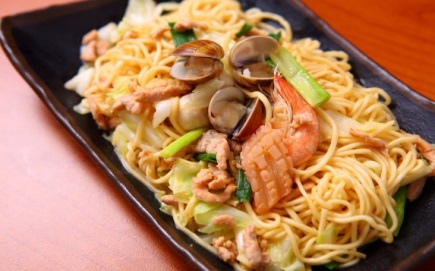去年(民國102年)蕃薯藤公布全台十大美味炒飯評選的結果,造成十足的話題性,觀察入選名單,前三名皆為北部店家,接著就是位在嘉義的慶昇小館,可說是南部第一名的炒飯。
「慶昇小館」於民國79年開業,當時這一帶為南北貨的集散地,酒家眾多相當繁榮,戲院更是到處林立,慶昇戲院、華南戲院、新榮戲院等都是當時著名的大戲院。創辦人江榮基曾是現在嘉義知名伴手禮福義軒的老師傅,自己也開工廠製餅,但遇餅業蕭條的時期,只能收山另覓新路,恰好親戚是慶昇戲院的經營者,才有幸在慶昇戲院騎樓下擺攤,「慶昇小館」就是因此得名。
「慶昇小館」最初本只有販售麵食,但觀察到看電影的顧客為了能準時進場,需要能快速飽餐的食物,加上南部氣候炎熱,以米飯為主食較容易有飽足感,江榮基將當時做餅的技巧應用在炒飯上,但剛開始做時,即使戲院開在附近,消費者並沒有想像中多,即使賣到半夜一整天卻賺不到三千元,只能咬牙撐下去。或許是不想自己的下一代經歷這種苦日子,當兒子江銘賢想要接手時,江榮基持反對的態度,他認為做小吃這行容易被看不起,說不定連老婆都娶不到,但學食品營養的出身的江銘賢,希望能將自己所學應用到家族事業上,即使父親反對仍堅持走這條路。
The Top Ten Gourmet Fried Rice Ranking in Taiwan published by Yam last year (2013) caused a sensation among the public. Taking a closer look at the shortlist, the top three were restaurants in northern Taiwan followed by CHING-SHENG Restaurant in Chiayi, thus it is said to be the no. 1 fried rice in southern Taiwan.
CHING-SHENG Restaurant opened for business in 1990. At the time, the region was a blooming distributing center for groceries, and there were also a large number of restaurants and renowned theaters such as Qingsheng (Ching-Sheng) Theater, Huanan Theater, and Xinrong Theater. Restaurant founder Rong-Ji Jiang was the old chef at the now famous souvenir supplier in Chiayi called Fuyishan. Although he too opened up his pastry factory, he was caught in the middle of an economic recession in the pastry industry, therefore he closed the factory and looked for alternative opportunities. Fortunately, one of his relatives is the owner of Qingsheng (Ching-Sheng) Theater and he was allowed to set up a stall at the arcade outside of Qingsheng (Ching-Sheng) Theater, hence the name CHING-SHENG Restaurant.
Originally, CHING-SHENG Restaurant only sold noodles, but after observing the cinema goers, he realized that in order to enter the theater on time, they needed food that could be served quickly. Furthermore, due to the hot climate in the south, rice as a staple food is more filling, therefore Rong-Ji Jiang applied his pastry technique to fried rice. However, during the startup stage, even with its closeness to the theater, the stall did not have as many consumers as he had imagined. Despite selling till midnight, he struggled to earn more than NT$3,000 per month, but he decided to persevere.
綁著頭巾、看起來酷酷的江銘賢,剛接下餐廳時,他也經歷了一段過渡期,最難熬的一段就是替餐廳找個合適店面的日子。從過去的小攤販到現址,共歷經三次搬遷,隨著流行電影院興起,舊時戲院漸漸沒落,最終逃不過拆除的命運,「慶昇小館」不得已曾搬到戲院對面營業,歷經多次尋覓,才發現這個同在新榮路的老房子。現在外觀亮麗的店在最初是個很破爛、被人戲稱為「鬼屋」的透天民宅,銀行甚至認為這裡根本生意不可能做成,不肯借錢給他,只好抵押家裡的工廠才有能力買下,他前後共裝修三次,徹頭徹尾改造這間破屋子,並注重油煙分離。他認為,炒飯是一種很容易被複製與取代的食物,只能自我向上提昇,提供顧客一個好的用餐場所,餐飲業也可以做得很體面。
「慶昇小館」以前炒飯只單賣蛋炒飯,江銘賢覺得太單調,又不想增加其他品項加重食材成本,因此他以蛋炒飯為基本元素,研發沙茶、番茄、豆瓣醬三種口味,尤其沙茶使用牛頭牌、番茄醬則是使用可果美,皆是已具有歷史的台灣品牌,每個台灣人對它們絕對不陌生,這也是江銘賢的用意,他希望吃到自家炒飯的人,一入口就會想到這是小時候品嚐過的媽媽的味道。炒飯所使用的牛肉也很講究,挑選被大家忽視的黃瓜條部位,肉質鮮嫩,讓客人以便宜的價格就能品嚐到等同於沙朗的美味。
因慶昇小館的發跡地就是在戲院旁,江銘賢希望自己的店能像電影一樣,能記錄過去、延伸未來,他與藝術家合作,在店裡舉辦地方性影像展,透過照片與畫,推廣在地文化,提升店裡的附加價值。嘉義市往往只是大家來阿里山順道經過的一個地方,「慶昇小館」希望能作為遊客來此的目的,做長時間的停留,深刻感受這裡的風土民情。
Perhaps he didn’t want his offspring to endure the hardship like he did, when his son Ming-Xian Jiang wanted to take over the family business, he adamantly opposed the idea because he believed that working in the snack food industry is looked down upon easily and it may even be difficult to find a wife. However, with an education background in nutrition science, Ming-Xian Jiang hoped to apply his knowledge to the family business, therefore he chose to walk down this path despite his father’s objections.
Wearing a headscarf and emanating a cool demeanor, Ming-Xian Jiang also experienced a period of transition when he first took over the restaurant, and the most daunting period was the days he spent looking for a decent storefront. From a small stall to the current address, the restaurant went through three relocations. With the emergence of popular cinemas, old fashioned theaters gradually became out of vogue and ultimately they could not escape the fate of demolishment. As a result, CHING-SHENG Restaurant had no choice but to move its business to across the cinema. After searching high and low, Jiang finally found the old house situated on Xinrong Rd.
The attractive appearance of the restaurant’s modern façade masks the once dilapidated, run down condition of its former self, and the building was taunted as a “ghost house”, even the banks thought that there was no way he could start a successful business here and refused to loan him money. In desperation, he had to use the family factory as collateral to purchase the house, which underwent three renovations to completely revamp the broken-down architecture. Great care was taken to implement oil-smoke separation in the kitchen. He believes fried rice is an easily replicated and replaced food, therefore he strives for self enhancement by offering his patrons a wonderful dining environment and by making catering more glamorous.
CHING-SHENG Restaurant was initially founded next to a theater, hence Ming-Xian Jiang hopes that his restaurant can document the past and look into the future, just like a movie. Consequently, he has collaborated with artists to organize local image exhibitions; through photos and paintings, he aims to promote the local culture and elevate the added values of the restaurant. In the past, Chiayi was merely a place where tourists pass through on their way to Alishan, CHING-SHENG Restaurant wants to become a tourist destination where people can stay longer in order to appreciate the local customs and hospitality.
牛肉炒飯:使用農委會推廣的大林台梗米16號,加入牛頭牌沙茶醬,希望能喚起消費者記憶中的味道,使用牛肩背的邊,稱為黃瓜條,此部位肉質軟嫩,等同於沙朗牛排的口感。
Beef fried rice: Using Taiken 16 rice from Dalin, highly recommended by the COA, condiment such as Bull Head satay sauce is added to evoke the nostalgic flavor among the consumers. The chuck tender portion of the beef is used to give a tenderer, almost sirloin steak like texture.

海鮮炒麵:使用大雜燴的概念,將店內的海鮮食材通通放入,魷魚、魚丸、蛤蜊與蝦子等,用料相當豐富,相當有飽足感。
Seafood fried noodles: Using the concept of hodgepodge, seafood ingredients such as squid, fish balls, clams and shrimps are added to the noodle to create the sumptuous, filling dish.

餛飩湯:起初像扁食使用小顆的餛飩,因附近補習班多,為了填飽學生的肚子,改使用大顆的餛飩,分量足夠讓學生有體力能繼續上課。
Wonton soup: Originally, small wontons were used to produce this dish, however, in light of the restaurant’s proximity to cram schools, large wontons were adopted to fill up the students’ stomachs and replenish their energy for class.

蔥爆牛肉:與牛肉炒飯一樣使用黃瓜條的部分,起鍋時間拿捏恰當,味道濃郁、肉質鮮嫩,即使久放依然好吃。
Beef and scallion stir-fry: Using the chuck tender portion of beef as in the beef fried rice, the stir-frying time must be accurately controlled to create the rich aroma, tender texture that remain delicious even after it has been served for a while.

炒蛤蜊:使用早上去市場挑選的新鮮蛤蠣,能吃出海味的鮮,不加過多的調味,僅用九層塔與蔥做搭配,簡單又能吃到食物本身的味道。
Clam stir-fry: Fresh clams from the morning market are used to create the fresh, seafood flavor. No additional seasoning is added apart from basil and green onions. The simplicity of the dish allows the patrons to taste the original flavor of the food.

地址:嘉義市新榮路315號
電話:05-2270587
營業時間:10:00-20:30;週三公休
招牌菜:牛肉炒飯、海鮮炒麵、餛飩湯
交通方式:至嘉義火車站轉計程車約5分鐘車程
Address: No. 315, Xinrong Rd., Chiayi City
Telephone: 05-2270587
Business hours: 10:00-20:30: Closed on Wednesday
Signature dishes: Beef fried rice, seafood fried noodles, wonton soup
Transport and directions: Take a taxi from Chiayi Train Station, the restaurant can be reached in roughly 5 minutes.


 留言列表
留言列表

